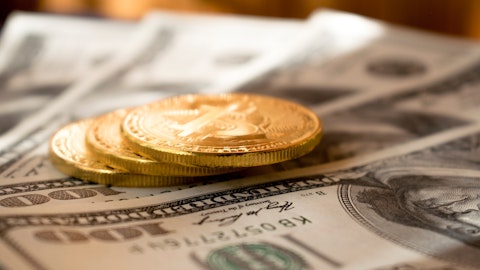Bank7 Corp. (NASDAQ:BSVN) Q3 2023 Earnings Call Transcript October 26, 2023
Bank7 Corp. misses on earnings expectations. Reported EPS is $0.85 EPS, expectations were $1.03.
Operator: Welcome to the Bank7 Corp’s Third Quarter Earnings Call. Before we get started, I’d like to highlight the legal information and disclaimer on page 25 of the investor presentation. For those who do not have access to the presentation, management is going to discuss certain topics that contain forward-looking information which is based on management’s beliefs, as well as assumptions made by and information currently available to management. Although management believes that the expectations reflected in such forward-looking statements are reasonable, they can give no assurance that such expectations will prove to be correct. Such statements are subject to certain risks, uncertainties and assumptions, including among other things, the direct and indirect effect of economic conditions on interest rates, credit quality, loan demand, liquidity and monetary and supervisory policies of banking regulators.
Should one or more of these risks materialize or should underlying assumptions prove incorrect, actual results may vary materially from those expected. Also, please note, that this conference contains references to non-GAAP financial measures. You can find reconciliation of these non-GAAP financial measures to GAAP financial measures in our 8-K that was filed this morning by the company. All participants will be in listen-only mode. [Operator Instructions] After today’s presentation, there will be an opportunity to ask questions [Operator Instructions] Please note this event is being recorded. Representing the company on today’s call, we have Brad Haines, Chairman; Tom Travis, President and CEO; J.T. Phillips, Chief Operating Officer; Jason Estes, Chief Credit Officer; Kelly Harris, Chief Financial Officer.
With that, I’ll turn the call over to Tom Travis.
Tom Travis: Thank you. Good morning and thank you for joining us today. We recently celebrated our five-year anniversary of our IPO and we’re happy with our results over the last five years and how we’ve had consistently strong earnings and compounded our shareholder value. And we’ve done that far better than just about any other financial institution. Our equity compounding and total shareholder returns are in pretty rare air and I’m sure in the top few percent of all banks. You can see these dynamics on page six of our deck as it shows the doubling of both of our EPS and tangible book value metrics. You can also see our total return when including dividend payments. Essentially, since the IPO, we’ve doubled our equity and our earnings and on top of that provided competitive dividend yields while doing so.
Our recent quarter was strong, clearly negatively affected by a one-off large credit event. We’ll touch on that shortly. In the meantime, we report record PPE, continued disciplined expense management, NIM strength, stable liquidity, properly matched balance sheet and we also note the absence of a meaningful AOCI adjustment. And with the exception of one adverse credit, our asset quality strength is consistent with our history. We take comfort knowing that our fundamentals carry the day. Before we move into Q&A, let’s spend some time on that one large one-off credit first. This is clearly a one-off situation as the rest of the portfolio is very strong. We do not see any weakness. In fact excluding that one credit, our past due loans and adverse credit grades are even better than the prior quarters and those quarters were strong as well.
So, our team has been together for decades and we’ve never experienced anything like what we are faced with on this one credit. And I’ll tell you on a personal level, it’s an extreme let down for sure. The credit in question is in litigation, the underlying borrowers in bankruptcy, so we have the need to be cautious with our comments. In addition to the specific reserve we took in Q3 shortly after closing the books, we became aware of a few significant new bankruptcy-related claims and we became also aware that the borrower and their consultants will take a significant amount of additional time to wrap it up, all of which costs money. And so, it required us in good faith to include a subsequent event note. In Q4, we will make an additional ACL increase or will take an actual write-down.
The amount will exceed the $3 million reserve we made in Q3 the range of possibilities is wide. And while it’s difficult to provide specifics due to the bankruptcy process, the outside larger possible amount could soak up much of the Q4 earnings. We would still expect even if that were to happen to report a strong return on equity year, based on information available today, even using the large possible lost amount. Our ROE would still be somewhere in the industry average and a little bit better. So really in a perverse way, it illustrates the strength of our core earnings to be able to take a meaningful hit and still perform where the industry performs. Regarding the one troubled credit again, we’re involved in litigation, but I want to make it really clear that this situation is not caused by errors in underwriting or collateral perfection or collateral valuation.
Rather, it is a case of we believe severe management failures which were then compounded by outside consulting and legal fees that are being paid from the cash collected, from the sale of our collateral. It is unfortunate to be in a position, where the sale of our collateral will generate almost twice as much as what the senior secured lender is owed, yet that won’t be sufficient enough to avoid a loss. The bottom line is the bankruptcy process is slow. It’s very expensive and it’s very lucrative for consultants and attorneys. And so without further commenting on that one situation, we’re moving forward. We have a very strong company. Our fundamentals are very good, and we expect to do what we’ve always done and that is to continue compounding equity in a very meaningful way.
And we’re really excited about our company, in spite of the one event. So with that being said, we’re here to answer any questions we can. Thank you.
See also 15 Largest Food Importing Countries in the World and 40 Most Visited Cities in the World in 2023.
Q&A Session
Follow Bank7 Corp. (NASDAQ:BSVN)
Follow Bank7 Corp. (NASDAQ:BSVN)
Operator: Okay. We will now begin the question and answer session. [Operator Instructions]. Our first question comes from Thomas Wendler with Stephens. Please go ahead.
Thomas Wendler: Hi, good morning, everyone.
Tom Travis: Good morning.
Jason Estes: Good morning.
Thomas Wendler: I just wanted to touch one time on the credit those moved on to nonaccrual. Can you give us an idea of when you’re expecting resolution on this credit?
Tom Travis: We think that — we looked at information this week. The probability is going to be the second quarter of next year. The bankruptcy process is maddeningly slow. And the final asset sale is going to occur here in a couple of weeks, and yet it’s still going to take that long to wrap it up.
Thomas Wendler: Okay. Thank you for that. And then just kind of thinking about some of your other larger relationships, can you give us an idea of the size of some of your larger relationships and then kind of your internal policies around those relationships?
Jason Estes: Sure. I would say, the number of relationships that exceed $25 million where you have like a single repayment source. And when I say single repayment source, I’m going to use an example. We have one group that owes us about $35 million, collectively. They operate in the QSR space. So, quick-serve restaurants operating over 100 different locations. And so when I say one repayment source, the vast majority of those are a single brand, but they’re scattered throughout different metros across the country. And so we’re still — I’m going to call that a single repayment source. So just bear with me there on that And so there’s really — there’s five relationships, that have a single repayment source where our balances exceed $25 million.
And so in that you’ve got as I mentioned QSR, we’ve got a broadband group. And of the five the bankrupt entity is the only one that doesn’t have strong personal guarantees, backing the credit. And so those relationships obviously, get a lot of scrutiny because of the size of the credits. This one is the outlier as far as personal secondary support. The other, I’d say there was five the one of the credit we’ve been discussing. Second one, you get QSR. Third, real estate with secondary support. Fourth, that’s a company that operates a broadband operation also has significant secondary support from an individual. And then you’ve got another entity, that is a manufacturing company and well secured also has secondary support.
Thomas Wendler: That was great color. Thank you. Thanks for answering my question guys.
Operator: Our next question comes from Nathan Race with Piper Sandler. Please go ahead.
Nathan Race: Great. Hi, guys. Good morning. Thanks for taking the questions. I’m sorry to go back to the large loan that moved to nonaccrual in the quarter, but can you just remind us all in terms of the size of your exposure there? Kind of what specific reserves you expect to take additionally on this credit in addition to what was allocated in the third quarter. I think the release alluded to some subsequent impairments in 4Q. And I know, it’s kind of a dynamic process at this point, and it could be prolonged in terms of the resolution to early next year. But any thoughts on just kind of the ultimate loss that you expect to take on this credit relative to the size of it?
Jason Estes: So make the loan amount so there’s — think of it as in two different tranches. You’ve got the prepetition debt and then you’ve got the DIP financing. And so we have partner banks and of the prepetition debt our share was just under $27 million as of 9/30. And then the remaining portion that gets you to the $40.5 million which is just over $13.8 million or $13.9 million. That’s our share of the DIP loans




